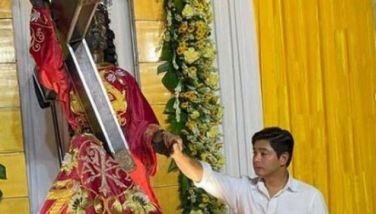Filipino sketch artist shines in Finding Dory
MANILA, Philippines – One of the riveting scenes in Finding Dory, the sequel to the Oscar-winning 2003 movie Finding Nemo, is the part when Dory and her sidekick Hank, a cranky seven-legged octopus, end up in the Kid Zone touch pool. Kids poke their hands and grab the fishes, much to the horror of Dory and Hank who must go past the pool and jump to another tank to survive.
That scene kept both adults and children, who attended the SM Megamall premiere, at the edge of their seats as they rooted for Hank and Dory to pull through the challenge.
Unknown to many, the Kid Zone Touch pool design was drawn by Filipino sketch artist Paulo Abadilla, who is one of the talented artists at Pixar and who has to his credits, designed the sets of the animated features like Monster University, and the Academy Award-winning movies Brave and Inside Out.
Paul breezed into Manila to promote Finding Dory, which rolls into cinemas nationwide beginning today.
In an interview with entertainment journalists and bloggers, Paul said he feels honored and happy to be a part of Finding Dory.
“We did a lot of work on the Kid Zone touch pool scene and I’m just glad that it was included in the movie. I was very involved in the design and I was able to oversee its production, from designing to carrying it over the technical department where they model it or digitally sculpt it. And I also applied the shading design that I specked for them and also the lighting design that I had painted. So we did a lot of work on that scene,” Paul said.
Paul, who joined the Pixar Animation Studios as an intern in June 2008, had also worked on the short films The Blue Umbrella, Pixar’s first television special Toy Story of TERROR!, LAVA and the Academy Award-nominated Sanjay’s Super Team.
Aside from Paul, other noted Filipinos working at Pixar include Gini Cruz Santos and Ronnie del Carmen. (Pinoys at Pixar are collectively called Pixnoys.)
“I think Filipinos are well-represented in the industry and we are a growing number. I think at Pixar, there are Filipinos from the different departments and even at the café, our chef is a Filipino so it is not unusual to see sisig or laing on the menu,” Paul said.
If Finding Dory is special to Paul, it’s because like Dory, he has always felt the desire to return to his roots and come home to the Philippines.
Born in Manila, Paul moved to California at the age of seven, and was raised in Milpitas and San Jose, California. Even though he practically grew up in the US, he never really forgot his place of birth and his home cities, Alabang and Pandacan, Manila.
“I do want to know where I came from. That’s why I can relate to Dory because the Philippines seems familiar. Just like Dory, I’m making my way back home. It’s about rediscovering things about my hometown and the things which I really miss like food and just being with the family,” he said.
Finding Dory, directed by Andrew Stanton, picks up after Finding Nemo where Dory, a blue Tang fish, is living with her clownfish pals Nemo and Marlin in Australia. Dory, who is afflicted with short-term memory loss, is nagged by flickers of memory of her family. She gets flashbacks as a young fish who is trained by her parents to muster skills for dealing with her memory troubles.
Then one day, while talking with them, she is suddenly whisked out to the ocean open by an undertow. Once in the sea, Dory quickly forgets why she’s out alone and just keeps on swimming until she meets new friends. She has a lucid memory of where her parents are and where they used to live. She tells Nemo and Marlin to accompany her in California. They then set out into an adventure at the Marine Life Institute to look for Dory’s parents.
Paul liked the theme of persistence in the movie, specifically the mindset of Dory who “lives in the moment” and does not let the past hurts in her life dampen her spirit.
“Dory’s motto is, ‘just keep on swimming.’ It is inspiring on how she lives in the moment. It reminds us not to be bogged down by the challenges in life, and appreciate already what’s in front of us. I think that is very valuable,” Paul said.
He shared that he’s become both of a go-with-the flow person and a planner.
“To go with the flow, I love that but I’ve always been a good planner. But as I mature, hopefully, I could go with the flow,” said Paul, who added that he would have been a surfer if he had not become a sketch artist because he loves the ocean.
During the interview, he was asked if he had incorporated something Filipino in his set design for the film just like what previous Filipino animators did in Finding Nemo where there was a bahay-kubo and a Mt. Mayon-inspired miniature volcano in the aquarium scene. Unfortunately, he was pressed for time as they had a hectic schedule.
“But I would have loved to. You see part of the designing is dressing the set, so maybe in the Touch pool scene, I would have put some tsinelas on the ground,” he said.
Working at Pixar has been a big learning experience for him, Paul said.
“It’s great being surrounded by all these talented people. It’s so awesome to just being able to pick their brain and learn from them. I feel like I’m always learning overtime I go to work, so it’s been great, it’s like school for me,” he shared.
Paul also said it’s a great privilege to work with Stanton.
“I work directly with him. I pitch my designs to him, seek his notes and feedback and if it’s appropriate to his vision. If he’s happy, we forge ahead with my design,” Paul said.
For him, the success of Pixar lies in the story and characters they built.
“The characters are so appealing and so are the stories. At Pixar, we always try to get it right, that’s why it takes us a long time to make these films. Crafting a really good story is very challenging. That’s where everything comes from. If we don’t have that right from the get-go, all the stuff that I do, (designing the environments) doesn’t mean anything if we can’t connect,” Paul explained.
He also shared that he likes Piper, Alan Barillaro’s six-minute short film that precedes Finding Dory, about a young sandpiper who learns the ropes of feeding, darting in and out of the surf by himself. The imagery is simply sublime.
Paul credits his family for instilling the values of hard work and persistence, and for also supporting his dreams.
“My Dad is the artist in the family. I was largely inspired by him while I was growing up, I would copy his drawings. I’m just lucky to have parents who enable me, supported me to draw and become an artist,” said Paul.
It wasn’t until he reached high school that he realized that he wanted to carve a career in sketching.
“I was watching those cartoons and I told myself, surely there’s a team of artists doing these stuff, so I said, it’s a possible career to happen and I’d like to do it,” Paul shared.
Paul graduated from San Jose State University, Summa Cum Laude with a Bachelor of Fine Arts in Animation and Illustration. Prior to joining Pixar nearly a decade ago, he interned with the Walt Disney Animation Studios as part of the Visual Development department.
For young, aspiring artists who would like to break out as animators in prestigious companies like Pixar, Paul has these pieces of advice.
“Get the training that you need, whether in animation or any other career, that’s one thing. Keep on practicing and get feedback from the people. It’s a huge thing when you apply for the position, and you get a feedback. Feedback is important. I also keep a sketchbook because it helps you hone your observational skills. Likewise, networking is also important. You’ll never know who you’re going to run into who could help you one day in your career. So you keep your contacts on social media and Linkedin,” Paul said.
He knows that he still has a long way to go, but for now, he just feels lucky to be in a job that allows him to do what he has always been passionate about — drawing. Someday, he would like to be an art director, but until then, he will just “keep on sketching.”
- Latest
- Trending


































